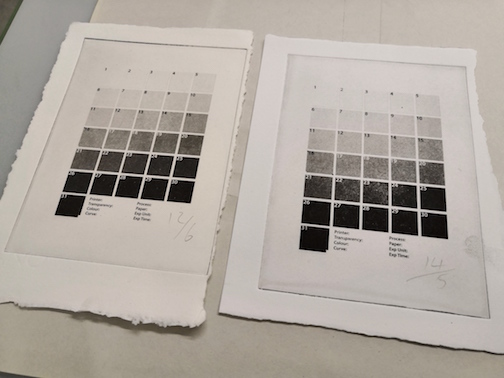I’m still struggling with calibrating my photopolymer plates. Well, its not so much the calibrating but getting a standard where I can actually calibrate the plates from.
Just to make sure, I have run through the whole custom adjustment curve process using a densitometer as demonstrated at the amazing workshop a few months ago at Lux Darkrooms. This is an alternative to using the usual ChartThrob photoshop script which I has been my goto tool for making digital negatives in the past.
This new technique (for me) uses a reflective densitometer to read each patch on a printed stepwedge which is then used to calibrate an adjustment curve in Photoshop.
Heres an image of a 31 step wedge from the workshop, you can see the tone of each patch is a fairly clean solid tone.

Now compare it to the one I recently made in my studio.

Notice how grainy/speckly each patch is!
I’m not exactly sure why this is happening. So I ran through a number of tests and changed one thing at a time similar to problem solving with wet plate collodion.
Is it exposure problems and open bite?
I went back to the very start and ran the base and image exposure test to make sure I had the exposures correct. They are.
Is it a problem with the actual plate?
Toyobo KM73, a standard photopolymer plate, used with success in the workshop. These are an old batch of plates that have been stored in the studio in a sealed box, apparently there can be issues with plates deteriorating over time due to environmental conditions. So maybe. Wish I’d known that before buying a largish number of plates. So a new batch of plates may be the answer?
Is it a problem with the digital transparency?
I dont think so, the grittiness cannot be seen on the inkjet positive transparency and talc is used between the plate and transparency.
Is it a problem with the aquatint screen?
My original test had resulted in poor blacks without this level of grittiness. That was with a Danish stochastic screen, which I have heard others have had issues with. So I ordered a recommended screen from the USA, at considerable cost after the surprise import charges!
Its the same screen as used at Lux Darkroom so I think it unlikely to be that.
Its a shame it arrived all crumpled in one corner even after being double packed in card tubing. Must have happened on packing. It was only the one corner and soon platted out in the vacuum press.

Is it a problem with the inking?
I dont think so, even though I’m a newbie to plate hand wiping ink, I dont think if I was over keen I would get such an even coverage over over wiping across the plate. It looks far too uniform.
And when I print a plate with just the screen exposure I get a silky smooth black print.
Is it a problem with the etching press?
I doubt its an issue with the press but more likely an issue with its set up. Have I set the pressure correctly? I dont think I can tighten it any further without me worrying about damaging something. There is a very good plate impression in the paper to indicate a good even pressure.
It may be the blankets. The press came with three blankets but I use two. Could the pattern be blanket texture. It has been suggested in my Instagram account (yes I now have one) that it may well be this. I’ll have to trial it. Although why did the screen only plate so well? Maybe the higher ammount of ink?
Is it a problem with the paper stock?
I tried several Fabriano papers to make sure, all soaked and blotted accordingly. Its still there.

Is it a problem with the washout / plate making process?
I changed the washout brush thinking it was too soft and trialled a firmer brush and a soft painters pad. Same results.
Water kept at same temp, plate dried adequately and cured under UV light.
Is it a problem with the exposure unit UV/Vacuum?
I was hoping it may be this as the old unit was the cause of mottling in the past. So I tried a standard contact printing frame. That didn’t help. It actually made contact between plate a film worse.
This all brings back the early days of frustration of wet plate collodion, the only plus side I can see is that over time, practice and patience I now consider myself fairly competent at wet plate.
Maybe the same will come of photogravure.
Happy New Year everyone.
Was it the blankets? I’m having this problem ????
Hi Ellen,
I never really narrowed it down. Its on my to do list once I’ve moved into the new studio. If you find out in the meantime please do let me know.
Tony